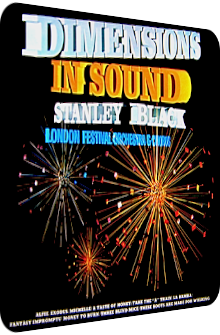
Stanley Black
Dimensions In Sound
1968
The prospects look grim, the front cover says it all, the title adds the final blow and one can move on, knowing that the above album is one of those stereophile intoxications prone to gather the latest Pop material while retaining some dignity by offering sophisticated material from the minds of classic composers. And yes, these things are all true when it comes to British pianist, arranger and composer Stanley Black (1913–2002) and his ten-track album Dimensions In Sound. Released on Decca Records in 1968, Black anticipates the conglomeration, blending as well as alteration of varied material which is then transformed into orchestral pieces.
Enoch Light’s Spaced Out (1969) comes to mind in this regard, as it brought three B’s to the table: Bach, Bacharach and some rock band called The Beatles. The focus is not as tightly set on Stanley Black's record. The London Festival Orchestra and its choir tumble from one cesspool into another, whether it is hillbilly music or genuinely graceful symphonies, everything is fair game here. Strangely enough, the album is not the mess it could have been! The strings and horns are aglow and deliver both languorous dioramas and smashing energy levels, but never for the sake of delivering audiophile material; the mood and quality are always the most important pillars. Even though there is an unexpected stringency adhered to the record, there are at times questionable arrangements of even more questionable songs, but thankfully, there is also delight to be found. It’s a hit-or-miss affair as usual, one which I dive further into below.
The opener comes as an admittedly unwanted surprise when viewed through Exotica glasses, for this composition is as far away from the Tropics as possible, its paradisiac title aside: Frédéric Chopin’s Fantasy Impromptu is a real fanfare, comprising of an impressive amalgamation of whirling strings, scything horns and pointillistic flutes. Even Chinese gongs are embedded. On the plus side, however, is the good-spirited eclecticism with all its harmonious overtones and occasionally melodramatic titrations. Billy Strayhorn’s Take The “A” Train, however, is the harbinger of all the intrinsic things to come. A swinging big band piece with a high profile Jazz note in Stanley Black’s hands, this classic feasts on the pristine textures of the horns and a mellow fluorescence. The drums solos are energetic, as are the bursting protrusions, but the glow, the agglutinating carefreeness and the field recording of said train make this side A’s true highlight!
Burt Bacharach’s and Hal David’s Alfie is of course dedicated to the eponymous movie of the British scallywag, but you wouldn’t notice any of this as the bittersweet ballad is presented here in a balmy way; a Balearic lead guitar dribs and floats in front of a hazy string mélange accompanied by a mixed choir. Sunlit and drowsy, Alfie hence shows the other side of the album title: sinecure instead of attack rates. While Lee Hazlewood’s These Boots Are Made For Walking is a handclap-infested hillbilly Folk dance with no banjos attached (that's for side B!) but an even greater focus on crushing timpani and plenty of brass instruments, Ernest Gold’s Exodus Main Theme is no stranger to Exotica experts due to its appearance on Arthur Lyman’s The Colorful Percussions (1962). Stanley Black’s vision is obviously much larger thanks to his orchestra. The pompous majesty of nature’s surroundings are encapsulated in glacial piano tones, bone-breaking dark counterparts and cinematic strings. Side A has come full circle, as this last piece resembles Chopin’s opener.
It is still not entirely decided whether the traditional La Bamba is a rad or fad, but from the 60’s onwards, its decade-spanning impetus could no longer be denied. Stanley Black uses this very tune as the kick-off artifact of side B, and as expected, there are fusillades of frizzling maracas and ligneous castanet clicks aplenty. Mexican-flavored solo horns unite with frilly flutes and handclaps, the choir is incredibly large, adding a curious wideness to an otherwise more intimate festivity. One John Lennon and Paul McCartney’s Michelle meanwhile genuflects before the changing times and offers an orchestral transmutation of a Rock ballad. And blimey, this endeavor works out! Sure, after all those tribute albums to The Beatles, this orchestral take is as arbitrary as any metamorphosis, I can relate to this sentiment. However, the relaxing monotony of the choir’s performance, the prominent jungle flute and the hazy shakers create a streamlined effort, and this is meant as a compliment. No histrionic outburst, no pretentious segue, just a diaphanous void.
Whereas David Heneker’s progressive Money To Burn is presented as a rustic rhythm-shifting banjo cataract complete with energetic drum solos, Dixieland movements and show tune vestiges, Robert William "Bobby" Scott’s A Taste Of Honey has next to nothing to do with Martin Denny’s sylvan take, as its physiognomy is comprised of withdrawn string helixes contemplating the gravitas of the very stage drama it is attached to. The finale is, if not eye-opening, then at least eye-widening: a rendition of the children’s song Three Blind Mice. I could leave it at that. Except that this crazy undertaking goes on for over eight minutes! From blotchy piano cascades over mountainous brass fanfares within Latin schematics to rolling timpani thunders, this is not a children’s song anymore. Instead, a gargantuan epic is presented. By the time the song is over, the children have become adults.
Fans of tropical vistas may move on immediately, as there is not much on Dimensions In Sound that suits their fancy, with the exception of the two compositions Michelle and Alfie whose dreamy remoteness camouflages all of the problems, hopes and obstacles these personae face through the existence which their respective mediums allow them. In other news, the aesthetics of Stanley Black’s string-driven journey are remarkably valuable due to a well-balanced coherence. It seems so obvious that this album is about oomph and audiophile adventures, but this is most certainly not the case at the end of the day. The enormous gestalts of Fantasy Impromptu and Three Blind Mice notwithstanding, Stanley Black makes sure that the Easy Listening aspect is cleverly interwoven into the material, whether it is of symphonic or popcultural nature. The source material shimmers through the phases and augmentations all the time.
Dimensions In Sound unfortunately has its fair share of clichés: Money To Burn and La Bamba delineate bleeding Latinisms and faux-Folk sceneries, but so does every other world-spanning album, be it truthfully exotic or orbiting around the genre’s periphery. Fans of orchestral visions with strong links to classic material such as side B of Edmond De Luca’s Safari (1958) will find great pleasure in this record. The album has been reissued on CD in 2005 by Vocalion and is coupled with A Tribute To Chaplin.
Exotica Review 370: Stanley Black – Dimensions In Sound (1968). Originally published on Aug. 30, 2014 at AmbientExotica.com.
